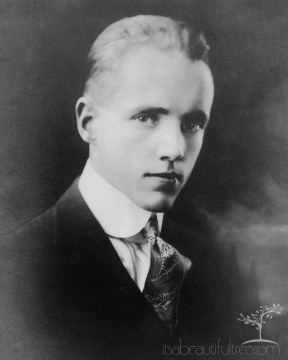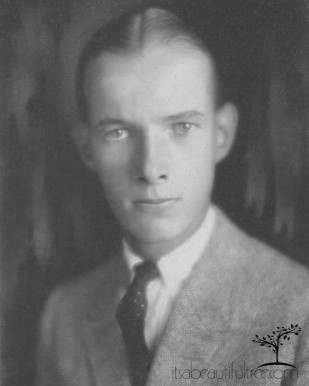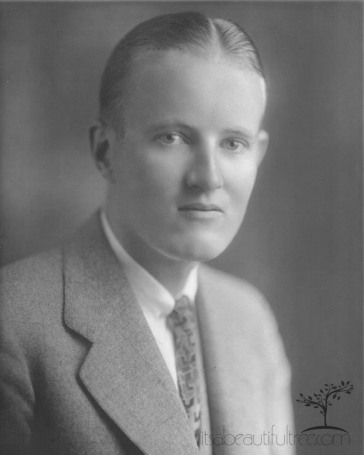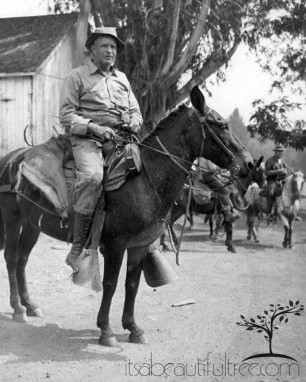William Stewart Dinwiddie Part VIII
The Russ Building, 1927. Main Contractor: The Dinwiddie Construction Company. Upon completion, the building was iconic enough that that Architect and Engineer Magazine wrote, “In nearly every large city there is one building that because of its size, beauty of architectural design and character of its use and occupancy, has come to typify the city itself.” The Russ Building was San Francisco’s tallest building from 1927 until 1964.
Between 1911 and 1916, the newly formed Dinwiddie Construction Company had built a number of the major structures in and around Portland. Having worked in the San Francisco Bay area with Thompson Starrett during the years after the earthquake, Bill was aware of the enormous growth potential in California. In 1916, the Dinwiddie Construction Company performed their first job in California for the Emporium Capwell Company.
The Dinwiddie Family Home at 2815 Oak Knoll Terrace, Berkeley, California. The home still stands today, though it looks very different.
By 1919, The Dinwiddie Construction Company had so many contracts in the San Francisco Bay Area that Bill decided to move the family back to California. By now, Bill and Helen had completed their family with five sons.
The Dinwiddie Family in the only known photograph of the entire family together, taken 1917. (Top left to right: Carrington, Bill, Starrett; Bottom left to right: John, Jim, Stewart, and Helen) Photo courtesy of Susan Wiley. An additional copy of the original exists in the Dinwiddie/Dirkes/Phelps private archives that had been Helen’s copy. However, Helen had been unhappy with the brightness of her dress in the print, so she hand retouched the image with dark pigment. The years have not been kind to her careful retouching, so as my gift to her, I have digitally retouched her dress, hopefully making it more to her liking. Garma–hope you like the results. -J
Dinwiddie Construction Company was thriving with all the new construction in the growing city of San Francisco. Some of the company’s early jobs included the Robert Dollar Building (1919), the Grocers’ Terminal (1921), the Golden Gate Theatre, Southern Pacific Warehouse, additions to the Hotel St Francis, and the Standard Oil Building (1922), the Holland Building in Oakland (1923), the Bush St Telephone Exchange (1924) Oakland’s Financial Center (1925) and Central Bank Buildings (1926), the Russ Building (1927), Grace Cathedral (1928), several buildings for Cal Berkeley, and many, many others—too many to list!
Grace Cathedral in San Francisco today (above) and during its 1928 construction (below). The notation at the bottom right indicates Dinwiddie Construction as the contractor. Photograph from the Grace Cathedral’s Pinterest Board.
Things were also progressing—and building—within the Dinwiddie family. In 1917 William Starrett (known by his middle name, Starrett), the oldest Dinwiddie son, had married Bernice Lucas in a simple and intimate ceremony in Portland, before making their home in Michigan and subsequently relocating to Oakland. Starrett and Bernice had two sons, William and Frank. For a short while, Starrett worked with his father at Dinwiddie Construction, but died at the age of 31 in 1928 of a tumor of the pituitary gland. (Photograph of Starrett during his time in the US Navy. Photo courtesy of Susan Wiley.)
 Goldwin Carrington, who also went by his middle name, also attended college in Michigan. He returned to California and married Harriet Rinder. The September 17, 1922 Oakland Tribune society column reported that the lavish ceremony at St Mark’s Episcopal Church was attended by more than 400 guests. Carrington and Harriet would have two daughters, Virginia “Gia,” and Harriet “Petie.” (Photo courtesy of Susan Fowler)
Goldwin Carrington, who also went by his middle name, also attended college in Michigan. He returned to California and married Harriet Rinder. The September 17, 1922 Oakland Tribune society column reported that the lavish ceremony at St Mark’s Episcopal Church was attended by more than 400 guests. Carrington and Harriet would have two daughters, Virginia “Gia,” and Harriet “Petie.” (Photo courtesy of Susan Fowler)
 John was 17 at the time of the move. After graduating from high school, he studied architecture at the University of Michigan and graduated in 1925. In 1930, the Oakland Tribune reported on the “charming simplicity and informality” of the home wedding of John Ekin Dinwiddie and Frances Matthews before a small group of relatives and close friends. John and Frances would have two children, Bettie and John. (Photo courtesy of Susan Wiley.)
John was 17 at the time of the move. After graduating from high school, he studied architecture at the University of Michigan and graduated in 1925. In 1930, the Oakland Tribune reported on the “charming simplicity and informality” of the home wedding of John Ekin Dinwiddie and Frances Matthews before a small group of relatives and close friends. John and Frances would have two children, Bettie and John. (Photo courtesy of Susan Wiley.)
 James—always known as Jim—was eleven when the family returned from Portland. He became the fourth Dinwiddie brother to attend the University of Michigan, and returned to Berkeley in 1930. Jim was interested in the family business and worked alongside his father to learn the ropes. Jim was the only one of Bill’s sons to remain with Dinwiddie Construction long after his father’s death. On Valentines Day in 1939, Jim married Julie Swobe in an intimate home wedding at the Swobe home in Berkeley. Jim and Julie would have two daughters, Helen and Nancy. (Photo from the Dinwiddie/Dirkes/Phelps personal archives.)
James—always known as Jim—was eleven when the family returned from Portland. He became the fourth Dinwiddie brother to attend the University of Michigan, and returned to Berkeley in 1930. Jim was interested in the family business and worked alongside his father to learn the ropes. Jim was the only one of Bill’s sons to remain with Dinwiddie Construction long after his father’s death. On Valentines Day in 1939, Jim married Julie Swobe in an intimate home wedding at the Swobe home in Berkeley. Jim and Julie would have two daughters, Helen and Nancy. (Photo from the Dinwiddie/Dirkes/Phelps personal archives.)
 William Stewart, who was always called Stewart, was four years old in 1919. Unlike his brothers, Stewart didn’t spend his childhood moving for his father’s work. Instead, he was able to enjoy his dad’s outdoor activities and California lifestyle from an early age. Stewart remained in California and attended Cal Berkeley. Stewart was an estimator for the Dinwiddie Construction Company for a short time before going into business for himself. In 1937, he married Jean Favier, and they had two children, Parker and Gail. (Photo from the 1936 University of Michigan Yearbook.)
William Stewart, who was always called Stewart, was four years old in 1919. Unlike his brothers, Stewart didn’t spend his childhood moving for his father’s work. Instead, he was able to enjoy his dad’s outdoor activities and California lifestyle from an early age. Stewart remained in California and attended Cal Berkeley. Stewart was an estimator for the Dinwiddie Construction Company for a short time before going into business for himself. In 1937, he married Jean Favier, and they had two children, Parker and Gail. (Photo from the 1936 University of Michigan Yearbook.)
Bill had known for quite some time that he suffered from high blood pressure, and had been warned by physicians for years to ease up on his activity. Since his early days at Burnham and Root, Bill had been known to spend hours on the job, not quitting for the day until he felt like it. Doctors had even warned him that his beloved hunting was just as strenuous as his business. Regardless of the fact that he enjoyed it, hunting did not allow for the rest and recuperation his heart and body needed.
 His reaction to being told “how to live his life” is best illustrated by an anecdote my grandfather, Jim, used to tell. Shortly after Bill had been told to cut back at work and relax, a friend dropped in to check on him at his office. Through the closed door, my grandpa, and everyone else within earshot, could clearly hear my great grandfather’s booming voice state: “Listen! Don’t feel sorry for me! I’ve had a hell of a good time in my life and so long as I live, I’m going to keep it that way! So long as I live, I’ll hunt when I like and have a drink when I feel like it! And don’t cry at my funeral! Just say, he had fun and enjoyed living!” (Photograph from the Dinwiddie/Dirkes/Phelps personal archives.)
His reaction to being told “how to live his life” is best illustrated by an anecdote my grandfather, Jim, used to tell. Shortly after Bill had been told to cut back at work and relax, a friend dropped in to check on him at his office. Through the closed door, my grandpa, and everyone else within earshot, could clearly hear my great grandfather’s booming voice state: “Listen! Don’t feel sorry for me! I’ve had a hell of a good time in my life and so long as I live, I’m going to keep it that way! So long as I live, I’ll hunt when I like and have a drink when I feel like it! And don’t cry at my funeral! Just say, he had fun and enjoyed living!” (Photograph from the Dinwiddie/Dirkes/Phelps personal archives.)
He did just that. He lived his life on his own terms.
William Stewart Dinwiddie, shortly before his death. Photo from the Dinwiddie/Dirkes/Phelps personal archives.
On the Monday before Christmas, 1932, Bill returned home from a duck hunt with his friends. He mentioned to Helen that we wasn’t feeling well, but seemed to bounce back quickly. On Wednesday, he went off to his office in the Crocker Building across the Bay in San Francisco as usual.
But things were not so normal on Thursday. Once again, he complained of not feeling well, and shortly before noon, Helen summoned the Berkeley Fire Department to the family home on Oak Knoll Terrace. Despite all the efforts of the BFD Inhalator Squad, William Stewart Dinwiddie died of a cerebral hemorrhage at home on the afternoon of December 22, 1932. He was 61.
Mountain View Cemetery Main Mausoleum, Oakland, California. Photograph by Julie Dirkes Phelps, 2001.
Though I’ve found no corroborating evidence to support the story, I’ve heard that there was a line around the block at his funeral. Employees, colleagues, friends, Elks, Masons, fellow golfers, and family all wished to pay their respects. Especially his employees. It’s also rumored that during the Depression, he never laid off a single man, an admirable act in times when so many found themselves on the unemployment lines. Following the 1932 Christmas Eve funeral service at the Dinwiddie home in Berkeley, William Stewart Dinwiddie was interred in a private ceremony at the Historic Mountain View Cemetery in Oakland, California. The Mausoleum in which he and many other Dinwiddies are interred, was built by The Dinwiddie Construction Company.
His sudden and unexpected death came as a shock to the building world, and was “an irreparable loss to the construction industry,” wrote Frederick W. Jones, editor of Architect and Engineer Magazine. “Only a couple of days before his death, it was the good fortune of the editor of this magazine to chat with Mr Dinwiddie in his office over matters of vital interest to the architectural profession and building trades… Mr Dinwiddie was a born builder; he understood the contracting business from A to Z and architect like to have him figure their work because they knew his estimating was dependable. When his company signed a contract, it was a guarantee that the job would be done thoroughly and well. Mr Dinwiddie was a very active man—too active, in fact, for a man his age—61, and the strenuous days which he lived, coupled with business worries characteristic of the times, are believed to have hastened the end.”
The Golden Gate Theatre (also known as the Junior Orphium Theatre). Built in 1922 by the Dinwiddie Construction Company. Vintage photograph.
The Dinwiddie Construction Company built the additions on to the Hotel St Francis. Countless famous travelers have stayed at the St Francis since its enlargement, including presidents, foreign heads of state, and movie stars. Vintage photograph.
Several of Bill’s descendants have attended the University of California at Berkeley. The Dinwiddie Construction Company Built the Life Sciences Building on campus in 1930. Photo: Vintage postcard.
The Men’s Gymnasium (above) and the Kress Building in Oakland (below) were still under construction when Bill died in 1932. They were completed on schedule. Photo Credits: University of California at Berkeley, and Oakland Historical Society.




There are so many things I love about this post, I’m not even sure where to start. Maybe with your wonderful storytelling, which so beautifully conveys your great-grandfather’s character and personality? I loved how you deftly you told his sons’ stories, too — reading between the lines I could get a sense of how different their personalities and ambitions were. And what a treasure the old photos are! You’ve really done something wonderful for students of genealogy, architecture, history here. And you’ve inspired me to document some of my own family’s stories before they’re lost. Thank you.
LikeLiked by 1 person
Thank YOU!!! I have written a “eulogy” for my great grandfather in my own cryptic style that I’m posting really soon. I am just deciding on pictures to use with it!!! While I was writing the eulogy, I kept thinking about my 4 year old son. He shows SO many traits of his great great grandfather. After my son had a massive Mexican Standoff with my parents, I said to my mother– I’ve spent the last month with a boy who “could be neither led, nor driven.” Something tells me WSD’s spirit is drawing on the walls of my playroom!– she totally agreed!
LikeLiked by 1 person
Julie
So many memories flood into my mind reading this chapter from stories I have heard and experienced through the years. Back in the late 1950″s I remember my father taking me to the Dinwiddie office at the Crocker building and looking out the window at the corner of Market and Montgomery Streets. Going up in an elevator that was so old it had an operator inside and the door was just folding gate.
The resting place for your California family, Mountain View Cemetery, is the same as mine. Many generations of Dinwiddie’s and Smith’s have built and expanded Mountain View through the years. I just happen to be going to Mountain View Cemetery tomorrow and I will be looking for the Dinwiddie name.
And as for the rumor regards Bill never laying off an employee, the Smith family has a bit of a twist on this….in our family the story goes that after the Depression your Great Grand Father told my Grand Father that he was going to have to lay him off and my Grand Father said that it wasn’t necessary…he would work for no salary until times got better. Interesting how each family has a little different slant on this story but there certainly be some truth in here somewhere.
Thank you for your hard work and wonderful recounting of the Dinwiddie family….these chapters are all wonderful to read.
Stephen
LikeLike
MY NAME IS PARKER ROSS DINWIDDIE AND I AM THE SON OF PARKER STARRETT DINWIDDIE AND JUST WANTED TO THANK YOU FOR THIS WONDERFUL INFORMATION THAT I CAN NOW SHARE WITH MY CHILDREN AND GRANDCHILDREN
LikeLiked by 1 person
Thank you so much for commenting! Parker, please email me!!!! I’m hoping to assemble more family information, and as the tree grows bigger and we get more and more spread out and separated by time, the task becomes harder and harder. My email address is itsabeautifultree at yahoo dot com (spelling it out to keep the spammers at bay!). There’s also a group of Dinwiddie/Starrett descendants on Facebook that I started to facilitate dialog between us all. Please keep in touch!
—Julie
LikeLike
I agree, Ross!
LikeLiked by 1 person
I am married to Gail Dinwiddie Thomson’s son. Gail was my best friend, a greater Mother-in-law a girl could never ask for. I’m am so proud to call this family my own! Thank you for writing this amazing and wonderful account!
LikeLiked by 1 person
Hi, my name is Grant Thomson son of Gail Dinwiddie Thomson daughter of William Stewart Dinwiddie and Jean Favier. Ross is my cousine. Thanks for the article.
LikeLiked by 1 person
I’m so happy that more Dinwiddies have found this and I hope we can call connect!!! I’m working on another project right now, but I’m planning on getting back to this one soon! I’m so happy you found this and that you reached out!
LikeLike
Can you tell me where the vintage photo of the Golden Gate Theatre came from? I’m trying to track it down for use in a video about Market Street. Thanks!
LikeLike
If memory serves me correctly, I pulled it from Google images. The only time I don’t give credit to original sources and/or photographers is when I can’t figure out who they are! I wish I could be more help to you. Shoot me a link to your video when you finish it. I’d love to see it! —J
LikeLike
Julie, Thank you for all the family information.
Jean Thomson, daughter of Gail Dinwiddie Thomson, granddaughter of William Stewart Dinwiddie and Jean Favier Dinwiddie.
I have been working on my own family tree, do you know if there are still copies of the family book on the Dinwiddie’s, I think I remember hearing about it.
LikeLike